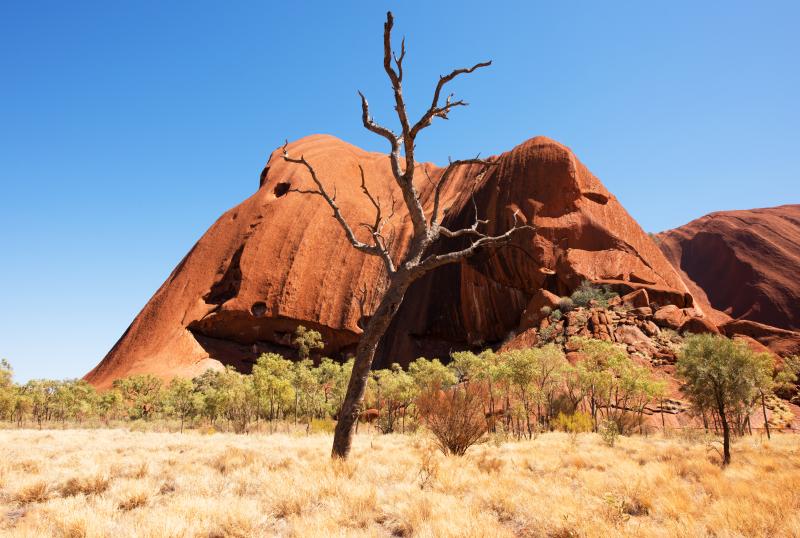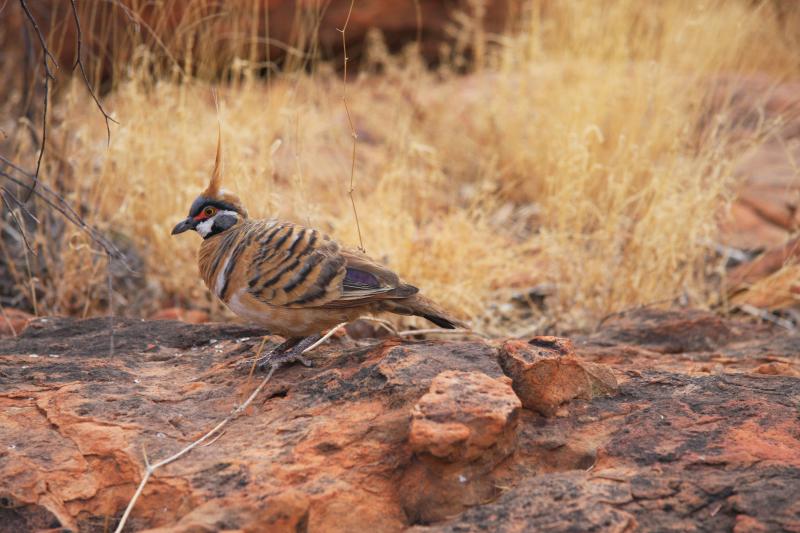View It
Visit It
Uluru-Kata Tjuta National Park
Australia
Visit Uluru-Kata Tjuta National Park
Uluru-Kata Tjuta National Park, located in the heart of Australia's Red Centre, offers an unforgettable experience steeped in ancient culture, geological wonders, and striking landscapes. The park is home to two of Australia's most iconic natural landmarks: Uluru (Ayers Rock) and Kata Tjuta (The Olgas). Uluru, a massive sandstone monolith standing 348 meters high, is not only a spectacular sight at sunrise and sunset when it shifts colors from ochre to burnished orange and deep red, but it is also a deeply sacred site for the Anangu, the traditional Aboriginal owners of the land. Visitors are encouraged to learn about the Anangu culture and the area's rich history through guided tours and cultural centers.
Kata Tjuta, roughly 25 kilometers to the west of Uluru, is equally mesmerizing. This group of large, domed rock formations, numbering 36 in total, are spread over an area of more than 20 kilometers. Walking trails here, such as the Valley of the Winds, offer breathtaking walks through diverse landscapes, ranging from narrow creek beds to sweeping lookouts with panoramic views. The walks vary in difficulty, providing options for both seasoned hikers and those looking for a more leisurely stroll. The geological history and the cultural stories associated with Kata Tjuta make it a profound place for reflection and discovery.
Visiting Uluru-Kata Tjuta National Park is not only about witnessing these incredible natural sights but also about understanding and respecting the cultural significance that these places hold. The park offers a range of activities that help visitors engage with the environment and the local Anangu culture. From viewing ancient rock art sites to participating in cultural workshops that include bush food tastings and traditional storytelling, the experiences are designed to be enriching and respectful. Nighttime brings a different kind of spectacle, with the clear desert skies offering some of the best stargazing opportunities. Whether you're watching the stars, listening to the quiet of the desert, or watching the sunrise paint Uluru in hues of red and orange, a visit to Uluru-Kata Tjuta National Park is a profound reminder of nature's beauty and the enduring legacy of Australia's indigenous cultures.
Uluru-Kata Tjuta National Park Monthly Weather Conditions
LOW
TEMP
HIGH
TEMP
DAYS OF PRECIP.
January
59°F
97°F
1
February
64°F
95°F
2
March
59°F
86°F
5
April
54°F
81°F
1
May
46°F
77°F
1
June
41°F
68°F
1
July
41°F
68°F
1
August
41°F
73°F
1
September
46°F
86°F
1
October
55°F
86°F
1
November
57°F
86°F
1
December
59°F
95°F
1
Need to Know Before You Go To Uluru-Kata Tjuta National Park
Find your Next Adventure in Uluru-Kata Tjuta National Park
Explore Uluru-Kata Tjuta National Park
- Dual World Heritage Site
Uluru-Kata Tjuta National Park is unique in that it is listed as a World Heritage Site for both its natural and cultural values. It was first inscribed in 1987 for its geological formations and then again in 1994 for its cultural significance to the Anangu, the traditional owners.
- Ancient Formations
Uluru (Ayers Rock) and Kata Tjuta (The Olgas) are believed to be about 500 million years old. However, the rock formations have been exposed above the surface for around 350 million years.
- Uluru is Not the Biggest
While Uluru is the more famous of the two major features in the park, Kata Tjuta is actually larger in terms of area. Kata Tjuta is a group of large, domed rock formations which cover an area of 21.68 square kilometers, compared to Uluru's 3.33 square kilometers.
- Changing Colors
One of the most remarkable aspects of Uluru is its ability to change color at different times of the day and year, particularly at sunrise and sunset when it can shift from ochre to burnished orange and intense red.
- Sacred Sites and Stories
Both Uluru and Kata Tjuta are considered sacred by the Anangu people. Many of the paths around and on Uluru are associated with traditional Tjukurpa (Dreamtime) stories, and some areas are restricted from public access.
- Climbing Ban
Climbing Uluru was officially banned in October 2019, in respect to the indigenous culture. The Anangu have always requested that visitors not climb Uluru due to its deep spiritual significance.
- Flora and Fauna
The park is home to an array of wildlife, including more than 21 species of native mammals, 178 species of birds, and 73 species of reptiles. Remarkable flora, adapted to the harsh desert environment, also thrives here.
- Massive Underground Water Sources
Uluru is like an iceberg - what is visible above ground is only a small part of its mass. It extends several kilometers into the ground, which is one reason why it has remained so stable over millions of years.
- Tourism and Management
The park is co-managed by the Anangu people and Parks Australia. This partnership helps ensure that the park is managed both for conservation purposes and to respect its cultural significance.
- Astronomical Significance
Some Aboriginal stories associated with Uluru and Kata Tjuta include references to constellations, the sun, and the moon, indicating a deep understanding of the celestial landscape which guided the Anangu's seasonal nomadic lifestyle.
Featured Picture Gallery

Visit Ayers Rock to Explore the Lush Landscape of Kata Tjuta

Hiking Throughout Ulura Kata Tjuta is a Common Tourist Experience

Experience Breathtaking Views During Your Hike Through Ulura Kata Tjuta National Park

Explore the Scenery and Find Native Wildlife
Explore Similar Locations
Banff

Grand Canyon

Tanzania

Patagonia

